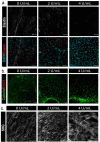This is a preprint.
ELASTIC FIBERS DEFINE EMBRYONIC TISSUE STIFFNESS TO ENABLE BUCKLING MORPHOGENESIS OF THE SMALL INTESTINE
- PMID: 37502968
- PMCID: PMC10370103
- DOI: 10.1101/2023.07.18.549562
ELASTIC FIBERS DEFINE EMBRYONIC TISSUE STIFFNESS TO ENABLE BUCKLING MORPHOGENESIS OF THE SMALL INTESTINE
Update in
-
Elastic fibers define embryonic tissue stiffness to enable buckling morphogenesis of the small intestine.Biomaterials. 2023 Dec;303:122405. doi: 10.1016/j.biomaterials.2023.122405. Epub 2023 Nov 17. Biomaterials. 2023. PMID: 38000151 Free PMC article.
Abstract
During embryonic development, tissues must possess precise material properties to ensure that cell-generated forces give rise to the stereotyped morphologies of developing organs. However, the question of how material properties are established and regulated during development remains understudied. Here, we aim to address these broader questions through the study of intestinal looping, a process by which the initially straight intestinal tube buckles into loops, permitting ordered packing within the body cavity. Looping results from elongation of the tube against the constraint of an attached tissue, the dorsal mesentery, which is elastically stretched by the elongating tube to nearly triple its length. This elastic energy storage allows the mesentery to provide stable compressive forces that ultimately buckle the tube into loops. Beginning with a transcriptomic analysis of the mesentery, we identified widespread upregulation of extracellular matrix related genes during looping, including genes related to elastic fiber deposition. Combining molecular and mechanical analyses, we conclude that elastin confers tensile stiffness to the mesentery, enabling its mechanical role in organizing the developing small intestine. These results shed light on the role of elastin as a driver of morphogenesis that extends beyond its more established role in resisting cyclic deformation in adult tissues.
Keywords: buckling; elastin; gut looping; mechanobiology; soft tissue mechanics.
Conflict of interest statement
DECLARATION OF COMPETING INTERESTS: The authors have no competing interests to disclose.
Figures





Similar articles
-
Elastic fibers define embryonic tissue stiffness to enable buckling morphogenesis of the small intestine.Biomaterials. 2023 Dec;303:122405. doi: 10.1016/j.biomaterials.2023.122405. Epub 2023 Nov 17. Biomaterials. 2023. PMID: 38000151 Free PMC article.
-
Material properties of the embryonic small intestine during buckling morphogenesis.Acta Biomater. 2025 May 15;198:257-266. doi: 10.1016/j.actbio.2025.03.055. Epub 2025 Apr 1. Acta Biomater. 2025. PMID: 40180004
-
MATERIAL PROPERTIES OF THE EMBRYONIC SMALL INTESTINE DURING BUCKLING MORPHOGENESIS.bioRxiv [Preprint]. 2024 Aug 9:2024.08.07.606927. doi: 10.1101/2024.08.07.606927. bioRxiv. 2024. Update in: Acta Biomater. 2025 May 15;198:257-266. doi: 10.1016/j.actbio.2025.03.055. PMID: 39149332 Free PMC article. Updated. Preprint.
-
Mechanical Properties and Functions of Elastin: An Overview.Biomolecules. 2023 Mar 22;13(3):574. doi: 10.3390/biom13030574. Biomolecules. 2023. PMID: 36979509 Free PMC article. Review.
-
Basic components of connective tissues and extracellular matrix: elastin, fibrillin, fibulins, fibrinogen, fibronectin, laminin, tenascins and thrombospondins.Adv Exp Med Biol. 2014;802:31-47. doi: 10.1007/978-94-007-7893-1_3. Adv Exp Med Biol. 2014. PMID: 24443019 Review.
Cited by
-
GABA tone regulation and its cognitive functions in the brain.Nat Rev Neurosci. 2023 Sep;24(9):523-539. doi: 10.1038/s41583-023-00724-7. Epub 2023 Jul 26. Nat Rev Neurosci. 2023. PMID: 37495761 Review.
References
Publication types
Grants and funding
LinkOut - more resources
Full Text Sources
Molecular Biology Databases
